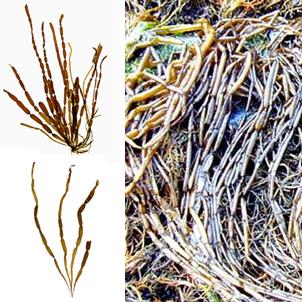| Authority: C. Agardh |
Type species: Scytosiphon lomentaria (Lyngbye) Link, nom. cons. |
|
| Commercial species: lomentaria (LOM) |
|
| Common names: Hime-kayamo, Ito-kayamo, Kayamonori, Leather tube, Mugiwara-nori, Sausage seaweed, Sugara, Tube weed, Yore-kayamo |
|
|
| Classification: Eukaryota, Phylum Heterokontophyta, Order Ectocarpales, Family Scytosiphonaceae. |
|
| AlgaeBase names and species: 49 names - 7 current as of 12-2001. |
|
|
|
|
| DiveBorneo SeaPlant Utility Rating |
 |
Minor sea vegetable source - wild harvest. |
|
|
Description
Tubular unbranched thalli that are solid when young, but become hollow on maturity. Hollow ends of thalli are either constricted at short intervals or are unconstricted. Thalli are usually compressed and twisted in close spirals for a part of their length. Hairs arise singly on superficial cells. Up to 50 cm in length. Light olive to dark brown colour. Constrictions give the appearance of sausage links. Reproductive organs broadcast gametes into the water where they fertilise and go through additional portions of a complex life cycle that is photosensitive.s |
Habitat
Rocky intertidal beaches on rocks and in tide pools. Sometimes occurs in areas with fresh water seepage |
|
 |
| click image & go to source |
|
Scytosiphon production
click country to go to GIS |
Tons per annum
wild harvest |
Tons per annum
cultivated |
| France |
n/a |
0 |
| North Korea |
n/a |
0 |
| South Korea |
n/a |
0 |
| Total |
n/a |
n/a |
0 |
|
Production
Harvest levels unknown. |
Biology & Agronomy
Wild harvest. |
Chemistry
In preparation |
Processing
We have several monographs in progress covering analytical procedures post-harvest treatment and process technology. Check the processing index for available web pages and monographs. |
| Products, Uses & Applications |
| List of species' uses and community affiliations |
|
| Genus |
GenID |
SpID |
Species |
Uses |
Communities |
| Scytosiphon |
SY |
LOM |
lomentaria |
FH |
SV, WB |
|
| click to relevant uses or communities on the index/legend table below>>> |
|
|
|
|
 to uses to communities to uses to communities  |
|
|
|
| Scytosiphon is most strongly associated with the Seavegetables and Wellbeing communities. |